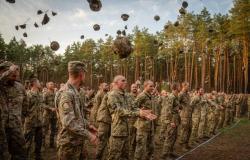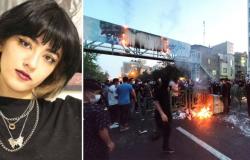in
The summary was created by ChatGPT and approved by Dagbladet.
Close
In short
- Ukraine and Russia have a rare diplomatic contact through the exchange of fallen soldiers.
- This is happening in the Sumy region, where a column of vehicles crosses the front line to deliver and retrieve bodies.
- The exchange takes place under the supervision of Russian snipers and is a risky operation.
- Over 24,000 Ukrainian soldiers have been registered as missing since the Russian invasion in February 2022, and 2,495 dead have been returned under the scheme.
- The exchange has been introduced at the initiative of the international Red Cross.
view more
– We go to their side because we don’t want Russian vehicles on our territory. There is of course a risk, but it is lower than if they came here, says Vitalyj Matvijenko in the Ukrainian military intelligence to the journalist of the British newspaper Telegraph.
They are located on Good Friday in the Sumy region in north-east Ukraine, on the border with Russian-occupied territory. A column of vehicles – a police car, a car with medical examiners and a freezer car with dead Russian soldiers – drives across the front line.
The road is covered with mines, which must be removed by Ukrainian soldiers before the column can pass.
Sharpshooters
Inside Russian-held territory, the bodies are delivered from the freezer. It is refilled with dead Ukrainian soldiers, after intelligence officers collate lists of ID information. Then the column moves back across the border.
The exchange takes place under the supervision of Russian snipers sitting in the trees nearby. When the last car is back on the Ukrainian-controlled side, the soldiers put the mines back in place.
PILE UP: Many Ukrainian cemeteries are filling up with fallen soldiers. Here from the village of Nakonetsjne Persje outside Lviv. Photo: Ralf Lofstad / Dagbladet
view more
This is one of the very few cases of functioning diplomacy between Ukraine and Russia during the ongoing war. The exchange of fallen soldiers takes place during a ceasefire which ends when the column has returned.
The scheme has been introduced at the initiative of the international Red Cross.
Third time
Over 24,000 Ukrainian soldiers have been registered as missing since the Russian invasion in February 2022. General Dmytro Usov, who oversees the “corpse corridor”, tells the Telegraph that 2,495 dead have so far been returned under the scheme.
The body exchange on Good Friday is confirmed by both the Ukrainian and Russian authorities. According to the Ukrainian headquarters for the treatment of prisoners of war, they received 121 dead, while the Russians were handed over 29, according to the Russian channel RBK.
Överstelöjtnant Joakim Paasikivi believes that if the war between Russia and Ukraine is not over within the next two years, it could continue for an uncomfortably long time. Video: Expressen/AP. Reporter: Christina H. Korneliussen
view more
This is the third publicly known exchange since the war began. During the previous one, on March 15, the Ukrainians were handed over 100 bodies, while the Russians received 69.
– Rear channels
– This primarily has a symbolic meaning; psychologically it is important to get the dead back and buried. It brings grief, but also peace, for affected family members and loved ones, explains Tom Røseth, associate professor, main teacher in intelligence and head of the Ukraine program at the Norwegian Defense College, to Dagbladet.
– It is also important to identify the deceased, so that they are not simply “missing in action”. Both sides are interested in doing this, although it is not always a high priority during military combat, he adds.
Røseth notes that the exchange is apparently resource-intensive; for the Ukrainians, it means crossing the front line into enemy territory.
– DIFFICULT: Tom Røseth at Forsvarets høgskole describes a demanding process for exchanging the fallen soldiers. Photo: Staff School / Defense College
view more
– Here we have a minimum of dialogue between the parties that is of mutual benefit, and, among other things, back channels are probably used, in addition to the fact that this is arranged by the Red Cross. It’s difficult, but they get it done, he says.
Questions about control
The associate professor describes a difficult task of keeping the exchange corridor open.
– Sumy has been such a passage over time, where the parties have exchanged prisoners of war, but there has recently been increased shelling, and Russian special forces have regularly come over to the Ukrainian-controlled side to spread fear, he explains.
Røseth also notes that more Ukrainian dead soldiers are handed over than Russian ones.
Experts: Could have been avoided
– Whoever gains territorial control also gains control over the dead. The Russians have taken control of territory around Avdijivka, and can thus have a number of Ukrainian soldiers to exchange – while the Ukrainians have taken little or nothing and therefore do not have so many Russian soldiers on their side.
Started as a 12-year-old
On the Ukrainian side, there is a group of volunteers, Black Tulip, which is responsible for the work of tracking down and collecting dead soldiers and returning them to their families.
– I have promised the dead to bring them home, explains the group’s leader Oleksyj Jukov to the channel Hromadske.
The Black Tulip leader often appears in media stories about dead soldiers, and has become something of a celebrity.

POSSESSIONS: The belongings of the dead Russian soldiers are painstakingly registered by the Black Tulip staff before the bodies are transported on. Photo: Jose Colon / Anadolu / NTB
view more
Zhukov says that he has been looking for dead and missing soldiers since he was 12 years old and saw how many remains of Soviet and German soldiers lay in the forest near his home in Slavyansk (in Donetsk), an area that changed hands several times during World War II.
– I saw how many were lying on the ground – cut up, dug up, thrown away as rubbish. Skulls, helmets and ammunition were scattered all over the forest. Since then I have been looking for those who died during the war, he explains.
– Burnt corpse
In Ukrainian intelligence, it is widely believed that the Russian army leadership takes it easy to return the bodies of its fallen, which are largely allegedly left where they were killed – so that the Kremlin can register them as “missing in action”.
– We found five Russians in the Lyman region [i Donetsk], the bodies were burned. There are people who try to hide their losses so they don’t have to take them with them. In other cases, locals burned the bodies because they smelled so bad, Zhukov told The Guardian.

EXPERIENCED: Oleksyj Jukov leads the volunteer group Black Tulip. He has been looking for corpses of soldiers since he was a child. Photo: Anatoly Stepanov / AFP / NTB
view more
In November 2022, the British newspaper spoke to dozens of locals from Kherson who said that Russian forces used a local garbage dump to burn the bodies of their own fallen soldiers during the six months the Ukrainian city was occupied. The allegations have not been commented on by the Russian authorities.
Demanding
The forensic “quality assurance” of the returned dead soldiers is painstaking. The bodies are mostly poorly prepared, and it can take over a month to finish processing one of them. DNA analysis, where the deceased’s genetic material is matched with that of family members, plays a central role.
– The main thing is to avoid making mistakes, explains chief DNA tester Vasyl Aksyonov at the police in the city of Cherkasy to the Telegraph.
One problem the investigators encounter is that family members refuse to provide DNA. They would rather believe that their loved ones are being held as prisoners of war than to have it confirmed that they are dead, explains Kostjantyn Dubonos, head of the Ukrainian State Forensic Agency, to the newspaper.

THROUGH THE CORRIDOR: The passage at Sumy is also used for prisoner exchanges. Here from January 3, when 230 Ukrainian soldiers were released. Photo: Ukrainian Presidential Office / AP / NTB
view more
– I thank God that he has returned the body, that we have it, says Alina, who lost her husband Mykola (33) at the front in Donbas in October 2022, to the Telegraph.
The body was returned through the corridor in the Sumy region in December of the same year, but not released to the family until July 2023.
The ID was confirmed by two DNA samples: one from Mykola’s brother, and one from the four-year-old son. Only when an indisputable match was in place could the body be handed over to the family.
– When they said it was a match – it was. I screamed. I cried, says the mother of two and widow.










